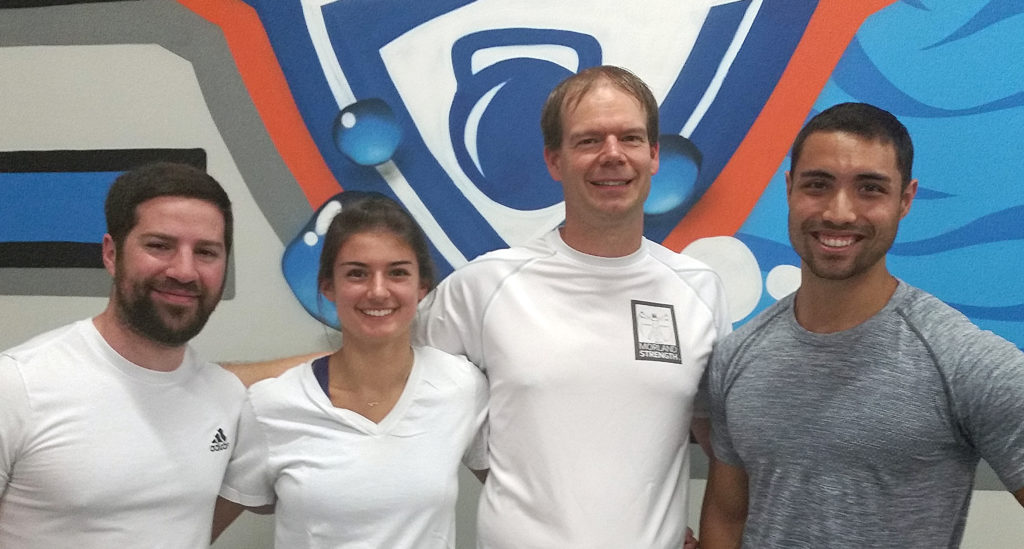In this new blogging series we will focus on the problems and solutions in Weightlifting in youth and for personal training clients today. This conversation has really been happening all across America for years in all gyms but we’d like to bring a new and fresh perspective. I’ve been a part of these Weightlifting discussions for 20 years in the context of Division I training, high school training, and other various clients. In this introduction to our series I’d like present some major problems with weightlifting in these two populations of youth and personal training clients. Our all-star blogging team of coaches to tackle this topic include: Amer Nahaas (Lifetime Fitness personal trainer), Sean Cowick (Camp Gladiator and personal trainer) and Erin Blaser (graduate student and Lifetime Fitness personal trainer), and myself in hopes to provide some great resources for you to address your specific problems in learning and coaching the weightlifting movements.
As we begin I’d like to ask you to remember back to where your experience in weightlifting began? How did your first session go? Who was your coach or trainer that got you started with weightlifting technique and cueing the movements? Was there an expectation to obtain the skills needed in one session, two sessions, or many sessions?
Add a blog post below so we can share your 1st Weightlifting experience with other readers!
For me, it began in the basement of a gym at Johnson County Community College in 1993 with an Eastern Block coach Istavan Javorek. This wiry, no-nonsense coach used a long stick in his hand and sometimes to my back to instruct me to:
- “get your butt down”
- “straighten your back”
- “keep the bar close to your body”
- “push the floor”
- “pull the bar explosively”
Then I transferred to the University of Tennessee in 1995 the first thing I heard from my weightlifting coach Tommy Moffitt say “Champions start with light weight.” That was a interesting thing to hear coming from my unique experience with a veteran strength coach and as a two-time national champion to hear. He was right and now I share this weight room wisdom regularly with my athletes as I seek to become a positive influence in their weightlifting development.
With these memories in mind of our first experiences in Weightlifting I’d like to present the major problems as I’ve seen them as we introducing the Weightlifting movements. During my experience coaching at NC State I surveyed incoming freshman from 2008-2011 about their experience in weightlifting in high school and these problems began to surface. Over time I began to see a pattern that more than 60% of my athletes had major with poor or no Weightlifting experience. This truth eventually led me to research my finding and devote my life to educating and coaching in the high school setting.
I divided the incoming freshman into 3 groups: no high school experience in Weightlifting, a poor experience, and a good experience. As the years advanced forward the first two groups continued to grow with little or no quality instruction. When I talked to the sports medicine staff I confirmed these trends and then with the clinical professionals that did physical therapy on site too. One local clinic reported that 20% of their clientele were youth and of these the majority has back issues due to improper Weightlifting instruction.
The major problems with youth weightlifting include:
- Lack of proper Weightlifting certification for the coach that has first contact
- Not a high enough standard for technique development for youth causing injury
- Coaches focus on lifting a lot of weight before the lifter is prepared to handle it
- The coach does not progress systematically from basic to more advanced skills
- The developmental lifts do not get emphasized enough
In personal training I’ve learned from the 40 young professionals I’ve mentored over the past 12 years who have either worked part-time or have invested significant time doing personal training. I have sought to educate and encourage these young professional to implement high standards in weightlifting with any clients when they are ready.
- In 2007 I mentored a sharp young professional named Matt Rupiper whose girlfriend was studying to be a personal trainer at the NPTI (National Personal Training Institute) in Charlotte, NC. The program was quite lengthy but included little on the facts and benefits of weightlifting. The team of instructors and students traveled over to NC State to participate in a presentation and hands on portion by Matt. As I met these aspiring personal trainers I learned many of the misconceptions and the major problems are:
The major problems with personal training clients in Weightlifting:
- Weightlifting is seen as dangerous and can get my client injured
- Weightlifting will put “bulk up” or become “muscle bound”
- The benefits of weightlifting are not greater than the costs
- Some gyms tend not invest the needed resources to get their young trainers certified and confident in the weightlifting movements
- Seasoned veterans to teach the Weightlifting movements are sparse
- Lack of correct equipment (high spin bars, bumper weights, and platforms)
If you’ve read this far I can assume you want to learn and grow in how to become a better coach that makes a positive influence on your young lifters and clients. That is simply what I seek to do and our team seeks to do as I call this process “looking for #ChampionMoments.” This is why our website exists to be that educational voice in providing excellent content, and a dialog to advise and speak with others that seek to do the same.
One of my former athletes from last year walked up to me at the football game last Friday night who is playing college football and said, “Coach Morland, I’d like to thank you for teaching me the weightlifting movements because my coaches in college said I’m one of the most knowledgeable and strongest freshmen entering this year.”
In conclusion, I sought to highlight some of the major problems in youth and for clients who are personal trained in Weightlifting movements. I know there are many gyms looking to be that positive influence like Brier Creek Crossfit where we took pictures and videos we’ll be using to lay out this blog series. I’d like to thank Kirk Sorenson (owner of Brier Creek Crossfit) and Luke Barthel (assistant Strength and Conditioning Coach at Duke University) for their support of MorlandSTRENGTH in this series and I’d invite you to not only follow this exciting fall series but to post your thoughts so we can explore the best solutions in Weightlifting for our youth and clients!
Chris Morland, MS, CSCS
Director of Strength and Conditioning/Teacher
Educator and Coach | Visionary in High School Strength and Conditioning
Would you like to follow Morland STRENGTH’s link here: new Instagram account?
#MorlandSTRENGTH #WeightliftingSeries
“The views, opinions, and judgments expressed in this message are solely those of the authors and peer reviewers. The contents have been reviewed by a team of contributors but not approved by any other outside entity including the Roman Catholic Diocese of Raleigh.”


